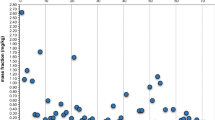Abstract
Cabbage reference material for pesticide multi-residue analysis was developed in accordance with the ISO Guide 35, ISO Guide 13528 and European Union Reference Laboratories-Proficiency Test standard protocols. Ten pesticides (acetamiprid, azoxystrobin, boscalid, buprofezin, carbendazim, difenoconazole, ethofenprox, imidacloprid, pyraclostrobin and tebuconazole) detected at relatively high levels in agricultural products in Korea were selected for this study. The developed material was evaluated for homogeneity and stability according to the statistical assessment method specified by international standards. Analysis of variance was carried out to calculate the within-bottle standard variation (s wb) and the between-bottle standard variation (s bb). Values of s wb and s bb varied by less than 4.7% of assigned values. Homogeneity was also assessed using Cochrane testing of outliers. All pesticides in the material were uniformly distributed within or between all bottles. Stability tests were conducted at room temperature (20–30 °C) for 12 days, under cold conditions (4–8 °C) for 40 days, under freezing conditions (− 20 °C) for 70 days and under deep freezer conditions (− 80 °C) for 234 days. Stability was evaluated based on the ISO Guide 35 statistical model, and results showed no significant decrease in stability during storage for any pesticide under any condition. We therefore conclude that the cabbage material could be used for future proficiency tests and/or validation of pesticide residue analysis.

Similar content being viewed by others
References
Rotenberg M, Shefi M, Dany S, Dore I, Tirosh M, Almog S (1995) Differentiation between organophosphate and carbamate poisoning. Clin Chim Acta 234:11–21
Carvalho FP (2006) Agriculture, pesticides, food security and food safety. Environ Sci Policy 9:685–692
Yarita T, Otake T, Aoyagi Y, Kuroda Y, Numata M, Iwata H, Watai M, Mitsuda H, Fujikawa T, Ota H (2014) Development of soybean certified reference material for pesticide residue analysis. Talanta 119:255–261
Rawn DF, Cao XL, Doucet J, Davies DJ, Sun WF, Dabeka RW, Newsome WH (2004) Canadian total diet study in 1998; pesticide levels in foods from Whitehorse, Yukon, Canada, and corresponding dietary intake estimates. Food Addit Contam 21:232–250
Senyuva HZ, Gilbert J (2006) Assessment of the performance of pesticide-testing laboratories world-wide through proficiency testing. Trends Analyt Chem 25:554–562
Grimalt S, Harbeck S, Shegunova P, Seghers B, Sejerøe-Olsen H, Emteborg H, Dabrio M (2015) Development of a new cucumber reference material for pesticide residue analysis: feasibility study for material processing, homogeneity and stability assessment. Anal Bioanal Chem 407:3083–3091
COMAR (2016) International database for certified reference materials. http://www.comar.bam.de/en/. Accessed 4 May 2016
Otake T, Itoh N, Aoyagi Y, Matsuo M, Hanari N, Otsuka S, Yarita T (2009) Development of certified reference material for quantification of two pesticides in brown rice. J Agric Food Chem 57:8208–8212
Otake T, Yarita T, Aoyagi Y, Kuroda Y, Numata M, Iwata H, Watai M, Mitsuda H, Fujikawa T, Ota H (2013) Development of apple certified reference material for quantification of organophosphorus and pyrethroid pesticides. Food Chem 138:1243–1249
Medina-Pastor P, Rodriguez-Torreblanca C, Andersson A, Fernandez-Alba AR (2010) European Commission proficiency tests for pesticide residues in fruits and vegetables. Trends Anal Chem 29:70–83
Kim Y, Song K, Shin S, Lee J, Jeong G, Hong E, Park J, Yu S (2010) Preparation of wastewater-based reference materials for heavy metal analysis and interlaboratory study. Anal Sci Technol 23:295–303
Jung J, Park J, Yoo S, Kweon S, Hong S, Sun Y, Park C, Choi C (2012) A study on the development of phthalate plasticizers CRM in ABS resin. Anal Sci Technol 25:273–283
Ahn S, Kim B, Hwang E (2011) Stability monitoring of pesticide residues in a chinese cabbage certified reference material. Bull Korean Chem Soc 32:1365–1367
Kim J, Choi S, Oh Y, Kwon Y, Hong S, Sung M, Lee S, Seo J (2016) Development of analytical reference material for proficiency test of pesticide multi-residue analysis in green-pepper. Korean J Pestic. Sci 20:211–220
Kim J, Oh Y, Choi S, Hong S, Kim S, Woo I, Kim J, Seo J (2016) Development of analytical reference material for proficiency test of pesticide multi-residue analysis in tomato. Korean J Environ Agric 35:223–233
ISO Guide 35 (2006) Reference materials–general and statistical principles for certification. International Organization for Standardization, Geneva
ISO 13528 (2005) Statistical methods for use in proficiency testing by interlaboratory comparison. International Organization for Standardization, Geneva
Thompson M, Ellison SLR, Wood R (2006) The international harmonized protocol for the proficiency testing of analytical chemistry laboratories. Pure Appl Chem 78:145–196
Kim J, Seo J, Moon J, Kim J (2013) Multi-residue method development of 8 benzoylurea insecticides in mandarin and apple using high performance liquid chromatography and liquid chromatography-tandem mass spectrometry. J Korean Soc Appl Biol Chem 56:47–54
Linsinger TPJ, Pauwels J, Van der Veen AMH, Schimmel H, Lamberty A (2001) Homogeneity and stability of reference materials. Accred Qual Assur 6:20–25
Acknowledgments
This study was supported by Grant No. PJ010857022017 from the Rural Development Administration (RDA), Republic of Korea.
Author information
Authors and Affiliations
Corresponding author
Rights and permissions
About this article
Cite this article
Kim, JH., Choi, SG., Kwon, Y.S. et al. Development of cabbage reference material for multi-residue pesticide analysis. Appl Biol Chem 61, 15–23 (2018). https://doi.org/10.1007/s13765-017-0336-2
Received:
Accepted:
Published:
Issue Date:
DOI: https://doi.org/10.1007/s13765-017-0336-2




